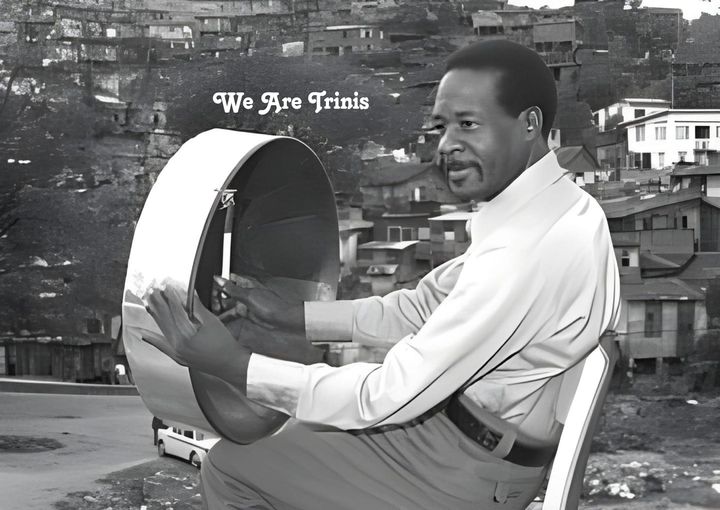 Joshua Regrello poses next to his Pan and the time panel marking the 31 hours in his bid for the Guinness Book of World Records for the longest pan marathon on December 28. - Grevic Alvarado IT’S OFFICIAL! Pannist Joshua Regrello is now a Guinness World Records title holder.
“I am now a Guinness World Records title holder for the longest marathon playing steelpan/steel drums,” he said on a social media post on May 30, confirming that Guinness approved his record-setting feat. Guinness recognised Regrello’s achievement of playing the steelpan continuously for 31 hours back in December. Regrello said, “Months ago, we came together with one mission: to make history through the power of steelpan and unity. Today, that dream is a global record.” He said the journey to official recognition was detailed. “Every requirement was carefully met and every standard upheld. But one thing mattered most to us, that the word steelpan, our national instrument and our pride, was included in the official record title. That representation means everything, and we have accomplished it.” Regrello thanked his intellectual property law consultant, Carla Parris, who, he said, liaised with the Guinness World Records offices in Miami and London. “To everyone who believed, supported near and far, from the early planning to the final note, thank you. We have done it. This is more than a personal milestone, This is a win for steelpan, our culture and our people. This is by all of us, for all of us.” (Source: Newsday, May 31, 2025)
0 Comments
With the global rise in popularity of our national instrument, the sweet sounds of the steelpan have become increasingly familiar, thanks to faithful members of our diaspora who act as good stewards of the culture to ensure that it is preserved and shared. One such individual is Wanda Atkins, president of Calyps’Atlantic, a steelpan ensemble based in the Western French city of Nantes. The isolation of the pandemic pushed Atkins to start thinking about using the internet as a medium to foster camaraderie between the disparate groups, and thus, the French Panorama was born. Now in its fourth year, the online event is still going strong and on April 26, roughly 300 players from eight bands across different cities show their skills and compete against each other with original arrangements and evaluated by a panel of esteemed judges both from T&T and abroad. This year’s lineup of judges includes Panorama’s first female title holder, veteran pannist and arranger, Michelle Huggins-Watts, former National Steel Symphony Orchestra (NSSO) artistic director and conductor Akua Leith, Northern Illinois University School for the Arts Steelband Director Yuko Asada and steelpan recording artist, Yoshihiro Harada, the first Japanese national to play in a T&T band. In previous years, American-born jazz musician and steelband arranger Andy Narell, Panograma founder Nevin Roach and half of DnK Steel, Danielle George were among those on the judging panel. Atkins spoke of the pushback she initially received after floating the idea to some colleagues in the French pan fraternity, saying that while they seem to love playing the instrument, getting the French players to associate music-making with competition was another thing entirely. The French, she explained, don’t view music as a competitive activity in the way that they do with sports.
“People were against it,” she admitted, surmising that she “must have talked to the right people,” as everything started getting off the ground not long afterward. The members of the French bands, while mostly from mainland France with a few hailing from the French West Indies, are not all newcomers to the instrument. Although many of them learned to play the instrument by rote, others are more seasoned musicians who have visited Trinidad and played with local bands—including Hadco Phase II Pan Groove and WITCO Desperadoes, among others—over the years. Keeping close to the culture The bands, although based in France, do not operate in a creative vacuum; rather, they remain very much connected to pan culture, keeping their finger on the pulse of what’s happening in Trinidad and Tobago, which allows them to ensure that their repertoire is up-to-date. Collaboration with veteran Trinbagonian arrangers and pan tuners is part of this effort. Multiple Panorama title holder, pannist and arranger Duvone Stewart is one such collaborator—he’s served as the band’s artistic director since 2003 and facilitates in-person workshops a few times a year. (You can read more about Stewart’s work with Calyps’Atlantic here.) For the love of pan With the event still in its nascent stages, there are no cash prizes for the winners; rather, the champions take home a trophy and earn bragging rights as those who managed to make the best impression on the experienced judges. But the event’s small budget aside, there’s more to the prize not being a monetary one—the French Panorama wasn’t created with the aim of fostering a competitive spirit around pan-playing, but rather to encourage cultural exchange and ambassadorship, build inter-group camaraderie and offer a virtual bridge for members of the various groups to share their love of the instrument where city lines and the business of transporting the instruments present logistical and financial hindrances. Atkins and the team at Calyps’Atlantic managed to pull off an in-person meeting of the bands only once so far, last May. In the cool warmth of spring, some 14 bands assembled for Pan’Fest, a free, open-air event that offered eager audiences arrangements of soca, calypso, as well as pop and soul numbers, showcasing the versatility of the instrument. Stewart attended as a guest of honour and spoken word artist and poet Anthony Joseph and his band wrapped up the evening. Good weather, delicious food—including a doubles stand run by Paris-dwelling Trini couple Carla and Justin Audroing—and sweet music made the day a success, however, it was an expensive, herculean undertaking to get all the bands in the same place. Atkins hopes to repeat this in subsequent years, perhaps even to have an in-person Panorama in the coming years. Her goal is to ensure that the French overseas territories are also included. It’s been more of a challenge to get the bands from the French West Indies to participate, however, this year, Reunion Island will be represented, and Atkins considers that a great start, considering the level of coordination across different time zones and cultures. In the end, an aspect of the French desire for non-competition remained in the concept, and the event has two categories, judged and non-judged, with participants free to choose which they enter. “A lot of people feel very intimidated to do it,” Atkins said. “So it would be a shame not to actually give them the possibility [to participate].” A bridge back home The first American-born child in a Trinbagonian family, Atkins spent most of her childhood in Connecticut, where she was introduced to music at a young age. “Piano saved me,” she said, recalling her school days in the US when she was faced with bullying and turned to the piano and the clarinet, among other instruments, as an escape. Leaving the music behind in early adulthood, it caught up to her when she relocated to Nantes in 1993 after her uncle sent her a tenor pan. “After I received the pan, everything changed,” she shared. The unique gift pushed Atkins to go in search of community in her new home, and with her musical background, she couldn’t accept such a gift and not use it. “I couldn’t just keep it in a box somewhere.” Atkins soon reawakened her musical side, joining the ranks of Calyps’Atlantic and finding community with the group that she is still a part of some 15 years later. She said that playing pan serves as a bridge back to the place she calls home, which, interestingly, isn’t Connecticut, but Roxborough and Arima, the places that have given her an appreciation for culture, a love of music, and the identity she wears with pride. She makes an effort to visit every year, immersing herself in the large families that welcome her with every trip. Through her work with Calyps’Atlantic and her organisation of the annual event, Atkins continues to maintain that bridge, expanding it a little further each year. She is proud of the work she’s done and is grateful to the many collaborators who join her in celebrating her home culture, who believe in the project and continue to help bring it to fruition. She revels in the atmosphere of community encouraged by the love of the instrument. “I see all the connections being made,” Atkins said, “It’s tradition, it’s identity. I can’t leave this behind.” The French Panorama will be broadcast live on their YouTube channel on April 26 at 2pm (Trinidad)/8pm (France) and will be available for viewing afterward. Check out the channel for interviews with the judges and performances from previous years and their Instagram page for updates. (Story by Tevin Gall, The Loop, April 3, 2025) At just 27 years old, Joshua Regrello has etched his name in history and hearts by attempting to set a Guinness World Records, for the Longest Marathon Playing Steelpan, surpassing an awe-inspiring 30 hours. This remarkable feat, filled with resilience, passion, and national pride, brought tears of joy to many as he carried the soul of Trinidad and Tobago in every note. Earlier this year, Joshua also made history as the first pannist to perform at the Great Wall of China, showcasing our culture on a global stage. Joshua’s journey is a testament to the power of determination and the magic of the steelpan—a symbol of our identity. (Source: Life in Trinidad, Dec 28, 2024). Watch interview with Joshua below.  Seeing that the STEEL PAN has OFFICIALLY been announced as Trinidad &Tobago's National Instrument, here's some history about it and its founder. 𝐃𝐨 𝐲𝐨𝐮 𝐤𝐧𝐨𝐰 𝐖𝐢𝐧𝐬𝐭𝐨𝐧 "𝐒𝐩𝐫𝐞𝐞" 𝐒𝐢𝐦𝐨𝐧? In the year 1930, Winston Simon was born at Rose Hill, East Dry River, Port-of Spain, Trinidad. He went, however, to live with his brother at Clinton Street (now Foster Street) in another community of the East Dry River, called John John. John John was an area surrounded by factories, which produced biscuits and other products that used tins and drums. The discarded containers were used by the youth in the area as instruments for their percussion band, which was a response to the official banning of the drum. In the John John band, Winston was a kettle drummer and played his kettle-drum, a rudimentary one-note instrument. It is believed that one night when the band was taking a 'jam' through the district, Winston loaned his instrument to a fellow member. When the kettle drum was returned, Winston noticed that the instrument had been destroyed, as much of its original convex playing surface had been beaten inward. As he tried to repair the instrument and return it to its original shape, by beating it from inside with a big stone, Winston observed that there were different sounds, tones or pitches emanating from various points of the surface of the tin. This discovery encouraged experimentation with the pounding of the surface of the tin using stone and wood alternately, which led to Winston being able to hammer out 4 distinct musical notes, thus producing a four-note pan in 1943 at the age of 13. In that same year, Winston was able to further develop his instrument into the eight note 'ping pong', which is considered the fore runner to the tenor pan of today. By 1946, Winston 'Spree' Simon's ping pong evolved into a pan of fourteen notes but the top of the pan was still convex, was beaten with plain sticks without the rubber and was not chromatically tuned. Following the ban of Carnival from 1939-45 as a result of World War 2, on March 5th 1946, Carnival Tuesday of that year, Winston 'Spree' Simon publically launched his fourteen note pan at the Broadway Carnival Competition in down town Port-of- Spain. At the competition Winston 'Spree' Simon played to an audience, which included the Governor Sir Bede Clifford and Lady Clifford, the Honourable Norman Tang, Audrey Jeffers and calypsonian, Lord Kitchener. He played classics, hymns and calypsos on his 14 note pan, including Schubert's Ave Maria, Kitchener's Tie Tongue Mopsy and God Save the King. Winston 'Spree' Simon was selected to join the Trinidad All Stars Percussion Orchestra in 1951, when the band went to tour London and Paris, in order to introduce the steel pan as an instrument to Europe. (Source: We are trinis, July 4, 2024) 900-foot mural depicting the entire history of Calypso will be started, this Calypso History Month, in Cemetery Street in Covigne, Diego Martin, as part of the historic ‘Diego Martin- Home of Calypso Project’ that was launched in 2023.
In a statement, the Artists’ Coalition of Trinidad and Tobago (ACTT) said the Upper Cemetery Street Residents Association (USCRA), the estates of a number of Calypso legends, and other Diego Martin stakeholders are collaborating with the ACTT in this groundbreaking project. The group said the project comes out of historical research showing Diego Martin’s bonafides as the "birthplace of Calypso", along with a series of startling intersections the new Borough has with Calypso history. The group said the first gesture in this declaration will be the commencement of the 900-foot mural which is to be completed by March 2025, in time for Carnival 2025. “The Mural will just be the first of many different initiatives that will be unveiled in the coming months and years to transform Diego Martin into an international Calypso Heritage destination. “The intention is for the first stage of painting (200-feet) to begin during Calypso History Month in October to get student participation. “However, for the next phase, about 400 feet of wall must be prepared by being plastered and reinforced alongside certain road-works that would need to be done by the Diego Martin Regional Corporation. “This work should be started and completed by year end so that the entire 900-foot wall could be completed in time for Carnival 2025.” The group said the mural will be a national and international tourist destination and will depict the entire history of the Calypso tradition from its roots in the Diego Martin slave plantations of the 1700s through its rise and explosion into a World Music in the 1900s. “The mural will depict hundreds of Trinidad and Tobago’s greatest musical talents like Sparrow, Kitchener, Rudder, Rose, Super Blue, Shadow, Stalin, Machel, Spoiler, Attilah, Tiger, and more in a stunning timeline pageant of portraits in colour." The group said the mural will be painted by some of Trinidad and Tobago’s greatest painters and muralists, whilst including school children, youth groups, elders, and more. The group said the entire community will be encouraged to ‘put a hand’ in the process. The group said the mural will transform the community of Covigne, particularly Cemetery Street, which has become desolate because of the dilapidated look of the unpainted wall which runs along almost its entire length. The group said all members of the neighbourhood have already given their permissions for the historic mural to happen on their walls. Meetings with the United Nations have also been had to discuss the larger Heritage implications of the project. The project has been endorsed by past Monarch David Rudder, as well as the estates of both the Mighty Sparrow and the Lord Kitchener. ACTT president Rubadiri Victor said: “The aim of the HOME OF CALYPSO Project is to attract up to 100,000 unique domestic and overseas visitors to Diego Martin annually- as well as other forms of tourism. This project could change the fate and face of Diego for the better and release multi-million-dollar entrepreneurial multipliers in the community. “It would also assist in the rehabilitation of the collapsing hillside communities and delinquent boys- from Patna, Bagatelle, and Covigne, amongst others. Ultimately the ‘Home of Calypso’ project could contribute toward generating and circulating millions of dollars in foreign exchange within Diego Martin, surrounding communities, and Trinidad & Tobago as a whole.” The group said Diego Martin was chosen as ‘The Home of Calypso’ following research conducted by Victor during a Commonwealth Foundation grant project. The research revealed the following fascinating cluster of facts: The first 6 Calypsonians mentioned in the historical record came from slave plantations in Diego Martin. One plantation in particular, the Begorrat plantation in Covigne, was seminally important to the establishment of the form. The group said the first three Calypsonians ever, Gros Jean (1790-1820), So So, and Papa Cochon (who also happened to be a legendary obeahman), came from Diego Martin. “The tomb of Gros Jean is located at the corner of Covigne Road and Richardson Street in Diego Martin at what was once the Bergorrat family cemetery. “Calypso was 'born' in the Covigne caves beneath Begorrat's great house. That Calypso was born in a cave is an incredible Creation Myth! The network of caves is said to extend all the way to West coast beaches like Macqueripe where Begorrat was rumoured to have run contraband and illegal slaves.” Victor said many of Calypso’s greatest Kings have taken up residence in the Diego Martin valley, including the Mighty Sparrow, the Lord Kitchener, Chalkdust, and David Rudder. “The first ever crowned Calypso King (1939), “The Growling Tiger” was born in Diego Martin. “Many other Calypso legends have also called Diego Martin home: Brigo, Funny, Lord Superior, Denyse Plummer, Marcia Miranda, the duo Regeneration Now, and brass bandleader Roy Cape. “One of the greatest writers of Calypso, the late Winsford Devine, also called Diego Martin home, alongside contemporary voices like Kerwyn Du Bois and Maximus Dan who were born there." The largest archive of Trinidad and Tobago music and Calypso also exists in Diego - the Shawn Randoo collection. Randoo is also a first-class historian of the genre. Victor said this is important as the two largest collections of Trinidadian and Calypso music both reside outside of Trinidad and Tobago. The first is located in Alaska with US historian and ex-judge Ray Funk. The second is located in Canada, recently sold by Trini-born Toronto native George Maharaj. Victor said: “That all of these important proponents of the Calypso artform have come to reside in Diego Martin, in the shadow of the Hills where Calypso was born, is amazing spiritual choreography.” “Calypso is one of the ten root musical forms in the Western world, in a list that includes Blues, Rock, R&B, Reggae, Jazz, and more. “The first Calypso recording was done in 1912- ‘Mango Vert’ by Loveys Band, making Calypso one of the oldest recorded pieces of music in the world, pre-dating Jazz by five years. “Calypso is also the mother-form for the music of the Caribbean basin as far north as New Orleans all the way down to the South American mainland. Reggae evolved from Calypso. “Calypso also precipitated the rise of West African music like Hi-Life and was instrumental in the re-routing of West African music back to their ancestral roots. “Calypso has profoundly influenced the trajectory of many forms of popular music from Disco, Afrobeat, Dancehall, and Reggaeton, to Afro Beats and EDM, etc. At the heart of all this is the power and always evolving majesty of the thing called Calypso.” To contribute or keep updated on the project, follow “Diego Martin Home of Calypso on Facebook: https://www.facebook.com/profile.php?id=100090180610072 Anyone interested in the project can call or message 1-868-797-0949. (source: the Loop, October 20, 2024) TWO iconic calypsonians will be honoured by the Tobago House of Assembly (THA) on October 25, to herald the official start of the third instalment of the Tobago carnival.
McCartha Linda Sandy-Lewis, also known as Calypso Rose, and the late Winston Bailey, stage name The Mighty Shadow, are two of eight icons, five posthumously, set to be honoured for their contribution to nation-building, culture and leadership. At a post-executive council news briefing on October 23, Assistant Secretary of Tourism, Culture, Antiquities and Transportation Niall George said the THA will celebrate the icons by renaming prominent streets and landmarks. The other six icons are legendary football coach Bertille St Clair; former chief administrator Allan Richards; the late politician and pharmacist James AA Biggart; deceased anthropologist Dr Jacob Delworth Elder; Aloysius Morean and Edna Morean (education), both deceased. Secretary of Infrastructure Trevor James said it is important to pay homage to those that have inspired Tobagonians over the years. In a media release on October 23, he said, “Tobago does not only have a proud heritage but also a collection of legends that have made their marks on the international stage and psyche of what it means to be Tobagonian. We are a great people deserving of honour, and as an Executive and citizenry, we owe it to them to recollect, recognise and celebrate, as a joint expression of gratitude, and for younger ones to see and be inspired as well.” The event is set to take place at the Scarborough Esplanade. As the carnival festivities began on October 23 with the Soca Titans competition, George predicted a bumper carnival season, set to culminate on October 27 with the parade of the bands. He said he has received reports from hoteliers that occupancy is at 100 per cent. “We’re also receiving reports of an increase in costume sales. I know there would be late persons trying to get on to the island, in that sphere, we are hoping that we receive the support that we asked for from both Caribbean Airlines and the Port Authority.” He said the theme of this year's event is mud and revelry, as he called on those who intend to patronise the events to make it unprecedented, whilst also making prioritising safety. “We would have done our last safety checks on last week Friday which would have been a tabletop exercise. We would have been presented with many scenarios and how they would be solved.” He added: “We are saying to Tobago, have fun, have clean fun and know that the background work would have been done so as to ensure that we have a very safe and successful carnival. I am saying to each and every one, let us enjoy the festivities to the best of our ability, let us come out, let us make the best of it.” He encouraged the patrons to make use of the spots after the festivities to take photos. “Enjoy the beauty of the island, enjoy the cuisine of the island, the warmth of the people on the island and let’s make it the best as we take this step in continuing to make Tobago the greatest little island on the planet.” (Source: Newsday, October 23, 2024) |
T&T news blogThe intent of this blog is to bring some news from home and other fun items. If you enjoy what you read, please leave us a comment.. Archives
May 2025
Categories
All
|





 RSS Feed
RSS Feed